Lots and lots of comics this week — including thirteen (!) Secret Wars tie-ins — so let’s just do it:
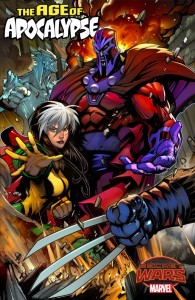 Secret Wars: Age of Apocalypse #1 (of 4) — Writer: Fabian Nicieza; Art: Gerardo Sandoval; Colors: David Curiel
Secret Wars: Age of Apocalypse #1 (of 4) — Writer: Fabian Nicieza; Art: Gerardo Sandoval; Colors: David Curiel
Secret Wars: Civil War #1 (of 4) — Writer: Charles Soule; Pencils: Leinil Francis Yu; Inks: Gerry Alanguilan; Colors: Sunny Cho
Secret Wars: 1872 #1 (of 3) — Writer: Gerry Duggan; Art: Nik Virella; Colors: Lee Loughridge
Secret Wars: Mrs. Deadpool and the Howling Commandos #2 (of 4) — Writer: Gerry 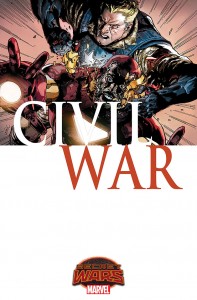 Duggan; Art: Salva Espin; Colors: Val Staples
Duggan; Art: Salva Espin; Colors: Val Staples
Secret Wars: Ghost Racers #2 (of 4) — Writer: Felipe Smith; Art: Juan Gedeon; Colors: Tamra Bonvillain
Secret Wars: Inferno #3 (of 5) — Writer: Dennis Hopeless; Art: Javier Garron; Colors: Chris Sotomayor
Secret Wars: Master of Kung Fu #3 (of 4) — Writer: Haden Blackman; Pencils: Dalibor Talaiic; Inks: Goran Sudzuka; Colors: Miroslav Mrva
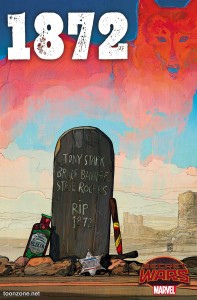 We’ll break these into two halves: in the first, the alphabetical lead-off is Age of Apocalypse, and it’s a typical example of the SW set-up: take the characters and plotlines from that dystopian alternate future, transplant them to a section of Doom’s jigsaw-puzzle Battleworld planet (with Apocalypse himself as the Doom-appointed baron), and turn them loose. As with many of these, your reaction to it will depend upon how fondly you remember the source material: if these versions of the familiar Marvel characters fascinate you, then Nicieza and Sandoval’s take on them will be faithful enough to meet your approval; if
We’ll break these into two halves: in the first, the alphabetical lead-off is Age of Apocalypse, and it’s a typical example of the SW set-up: take the characters and plotlines from that dystopian alternate future, transplant them to a section of Doom’s jigsaw-puzzle Battleworld planet (with Apocalypse himself as the Doom-appointed baron), and turn them loose. As with many of these, your reaction to it will depend upon how fondly you remember the source material: if these versions of the familiar Marvel characters fascinate you, then Nicieza and Sandoval’s take on them will be faithful enough to meet your approval; if  you’ve never read any of the originals, then it will be just another dark, confusing Elseworlds-type story. So too for Civil War, except that here the story is a lot more recent, and the characters more familiar, so the book itself is more accessible — but just as dark, since in this version the two sides of battling heroes never resolved their differences, and instead were manipulated (by Skrull sleeper agents? It’s never said, but that’s the implication…) into destroying much of New York City, and ensuring that the war would last for years, with the US divided pretty much right down the middle: Steve Rogers’ forces in the West, and Tony Stark’s in the East. Now, they’re having peace talks, but of course things don’t go that well. Soule has rapidly become one of Marvel’s better writers for this sort of thing, with sharp plotting and characterization,
you’ve never read any of the originals, then it will be just another dark, confusing Elseworlds-type story. So too for Civil War, except that here the story is a lot more recent, and the characters more familiar, so the book itself is more accessible — but just as dark, since in this version the two sides of battling heroes never resolved their differences, and instead were manipulated (by Skrull sleeper agents? It’s never said, but that’s the implication…) into destroying much of New York City, and ensuring that the war would last for years, with the US divided pretty much right down the middle: Steve Rogers’ forces in the West, and Tony Stark’s in the East. Now, they’re having peace talks, but of course things don’t go that well. Soule has rapidly become one of Marvel’s better writers for this sort of thing, with sharp plotting and characterization, 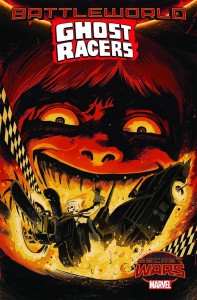 and the Leinil Francis Yu art is a good choice, since he was doing so many Avengers books back then, and thus the players all look the way they “should.” 1872 is one of the most intriguing uses of the SW concept: a Western, set in the small town of Timely, with Steve Rogers as the sheriff, Tony Stark as the town drunk, Wilson Fisk as the corrupt mayor, etc. Since we haven’t seen these versions of the heroes before, the book’s a clean slate, without a lot of backstory to summarize, and so watching the creators use many of the standard Western tropes to put them through their paces is intriguing fun. Mrs. Deadpool…, by the same writer, has Wade as a ghostly narrator, describing the adventures of his ex-wife, now married to Dracula, as she leads a group of Marvel’s supernatural characters on a quest to find an artifact that
and the Leinil Francis Yu art is a good choice, since he was doing so many Avengers books back then, and thus the players all look the way they “should.” 1872 is one of the most intriguing uses of the SW concept: a Western, set in the small town of Timely, with Steve Rogers as the sheriff, Tony Stark as the town drunk, Wilson Fisk as the corrupt mayor, etc. Since we haven’t seen these versions of the heroes before, the book’s a clean slate, without a lot of backstory to summarize, and so watching the creators use many of the standard Western tropes to put them through their paces is intriguing fun. Mrs. Deadpool…, by the same writer, has Wade as a ghostly narrator, describing the adventures of his ex-wife, now married to Dracula, as she leads a group of Marvel’s supernatural characters on a quest to find an artifact that 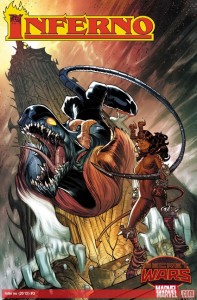 will defeat him. This suffers a little from being a Deadpool book without that much actual Deadpool in it, and trying to meld a semi-serious story with that title’s tongue-in-cheek style, but there are enough good bits (including a funny cameo from Bob the Hydra Agent) to keep its Deadhead fans satisfied. Similarly, Ghost Racers is for Ghost Rider fans, particularly of the most recent incarnation of that book (since Smith, the writer here, wrote that one too); if you liked that mangafied, street-racing version, with Robbie Reyes as the flaming-headed hero, then you’ll probably like this series, where bad-guy Arcade has captured all the various Spirit-of-Vengeance-infected riders, and forces them into a nightly Death Race 2000 obstacle course competition for the amusement of the population. Inferno, meanwhile, continues yet another X-Men-centered story, this one about Magik/Illyana and her demonic horde versus Goblin Queen Madelyne Pryor versus the X-Men; what applied earlier to Age of Apocalypse
will defeat him. This suffers a little from being a Deadpool book without that much actual Deadpool in it, and trying to meld a semi-serious story with that title’s tongue-in-cheek style, but there are enough good bits (including a funny cameo from Bob the Hydra Agent) to keep its Deadhead fans satisfied. Similarly, Ghost Racers is for Ghost Rider fans, particularly of the most recent incarnation of that book (since Smith, the writer here, wrote that one too); if you liked that mangafied, street-racing version, with Robbie Reyes as the flaming-headed hero, then you’ll probably like this series, where bad-guy Arcade has captured all the various Spirit-of-Vengeance-infected riders, and forces them into a nightly Death Race 2000 obstacle course competition for the amusement of the population. Inferno, meanwhile, continues yet another X-Men-centered story, this one about Magik/Illyana and her demonic horde versus Goblin Queen Madelyne Pryor versus the X-Men; what applied earlier to Age of Apocalypse 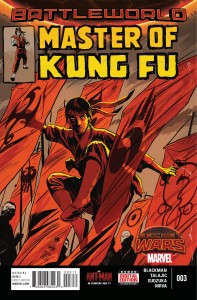 applies here, too — if you like the original story, you’ll like this, but otherwise maybe not so much — although this book is leavened with more humor, and thus a slightly lighter touch, than Age. Master of Kung Fu, already on its penultimate issue, looks like it’ll be the first of these mini-series to finish, and has Shang-Chi fighting a series of opponents, video-game style, in order to defeat his tyrant father; here, too, if you like the idea of all of Marvel’s martial-arts characters in one place (even if some of them are distorted versions of their true selves), then you’ll be a fan of this title.
applies here, too — if you like the original story, you’ll like this, but otherwise maybe not so much — although this book is leavened with more humor, and thus a slightly lighter touch, than Age. Master of Kung Fu, already on its penultimate issue, looks like it’ll be the first of these mini-series to finish, and has Shang-Chi fighting a series of opponents, video-game style, in order to defeat his tyrant father; here, too, if you like the idea of all of Marvel’s martial-arts characters in one place (even if some of them are distorted versions of their true selves), then you’ll be a fan of this title.
 Secret Wars: Runaways #2 (of 4) — Writer: Noelle Stevenson; Art: Sanford Greene; Colors: John Rauch
Secret Wars: Runaways #2 (of 4) — Writer: Noelle Stevenson; Art: Sanford Greene; Colors: John Rauch
Secret Wars: 2099 #3 (of 5) — Writer: Peter David; Art: Will Sliney; Colors: Antonio Fabela
Secret Wars: Spider Island #1 ( of 4) — Writer: Christos Gage; Art: Paco Diaz; Colors: Frank D’Armata
Secret Wars: Amazing Spider-Man: Renew  Your Vows #2 (of 5) — Writer: Dan Slott; Art: Adam Kubert; Inks: John Dell; Colors: Justin Ponsor
Your Vows #2 (of 5) — Writer: Dan Slott; Art: Adam Kubert; Inks: John Dell; Colors: Justin Ponsor
Secret Wars: Spider-Verse #3 (of 5) — Writer: Mike Costa; Art: Andre Araujo; Colors: Rachelle Rosenberg
Secret Wars: Squadron Sinister #2 ( of 3) — Writer: Marc Guggenheim; Pencils: Carlos Pacheco; Inks: Mariano Taibo; Colors: Frank Martin
The rest of the tie-ins: Runaways continues its 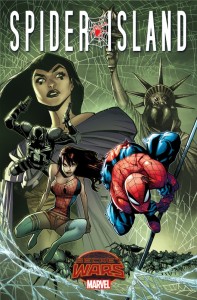 YA-centric mashup of Harry Potter and Hunger Games, as the title kids, all enrolled in a finishing school for super-powered youth, have to pass their senior exams in an arena-like setting that’s even more deadly than it looks; Stevenson, the co-writer of Lumberjanes, uses that book’s combination of serious adventure, humor and tight kid-gang characterization to good effect here, too, and Greene’s manga-influenced style is a good match for it. 2099 has Peter David, also an expert at combining humor, drama and action, doing his thing with Marvel’s alternate-future characters; cut and paste the earlier remarks
YA-centric mashup of Harry Potter and Hunger Games, as the title kids, all enrolled in a finishing school for super-powered youth, have to pass their senior exams in an arena-like setting that’s even more deadly than it looks; Stevenson, the co-writer of Lumberjanes, uses that book’s combination of serious adventure, humor and tight kid-gang characterization to good effect here, too, and Greene’s manga-influenced style is a good match for it. 2099 has Peter David, also an expert at combining humor, drama and action, doing his thing with Marvel’s alternate-future characters; cut and paste the earlier remarks 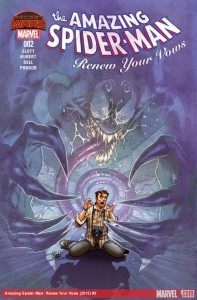 on Age of Apocalypse and Inferno and apply them to this book, too. Not to be outdone by the X-Men spinoffs, there are three Spider-Man versions this week: the debut, Spider Island, also is the most recent, covering the events in that Amazing Spider-Man plotline where everyone in Manhattan got spider-powers… but then started to turn into giant spiders. The bad news is that it suffers from a misleading cover (since (a) the book doesn’t have Ramos art, (b) Mary Jane isn’t in it, and (c) neither is Peter, since we find out early on that the timeline twist here is that he died, leaving the plague to rage unchecked, and the Flash Thompson venom as the main character); the good
on Age of Apocalypse and Inferno and apply them to this book, too. Not to be outdone by the X-Men spinoffs, there are three Spider-Man versions this week: the debut, Spider Island, also is the most recent, covering the events in that Amazing Spider-Man plotline where everyone in Manhattan got spider-powers… but then started to turn into giant spiders. The bad news is that it suffers from a misleading cover (since (a) the book doesn’t have Ramos art, (b) Mary Jane isn’t in it, and (c) neither is Peter, since we find out early on that the timeline twist here is that he died, leaving the plague to rage unchecked, and the Flash Thompson venom as the main character); the good  news is that it has a Spider-Girl backup story by May Parker’s original creative team, Tom Defalco and Ron Frenz, that will continue throughout all four issues of the book. Meanwhile, in other spider-news, Renew Your Vows continues its own tale about a Peter Parker who’s the parent of a (younger than May) girl, and has struggled to resolve his conflicting responsibilities as a father and a hero, while Spider-Verse continues to offer a buffet of spider-centric characters, including Spider-Gwen, Noir Spidey, Spidey from India, and the Spectacular Spider-Ham, against the Sinister Six and an unusually-benevolent version of Norman Osborn; it has the most cartoony art, which makes it read like an episode from some animated-TV version of the Wallcrawler (not that that’s necessarily a bad thing, especially after all the grimmer titles on display this
news is that it has a Spider-Girl backup story by May Parker’s original creative team, Tom Defalco and Ron Frenz, that will continue throughout all four issues of the book. Meanwhile, in other spider-news, Renew Your Vows continues its own tale about a Peter Parker who’s the parent of a (younger than May) girl, and has struggled to resolve his conflicting responsibilities as a father and a hero, while Spider-Verse continues to offer a buffet of spider-centric characters, including Spider-Gwen, Noir Spidey, Spidey from India, and the Spectacular Spider-Ham, against the Sinister Six and an unusually-benevolent version of Norman Osborn; it has the most cartoony art, which makes it read like an episode from some animated-TV version of the Wallcrawler (not that that’s necessarily a bad thing, especially after all the grimmer titles on display this  week). Finally, Squadron Sinister continues its look at the bad-guy versions of these characters (and, since they were originally a parody of the Justice League, making them very much like DC’s Crime Syndicate), as they kick the butts of, among others, the Frightful Four and Marvel’s military characters (the likes of Captain Savage and Combat Kelly not being particularly effective against Hyperion); since this group — or, at least, a version of them — is supposed to be part of Marvel’s relaunch in October, it’s a title that might be worth watching.
week). Finally, Squadron Sinister continues its look at the bad-guy versions of these characters (and, since they were originally a parody of the Justice League, making them very much like DC’s Crime Syndicate), as they kick the butts of, among others, the Frightful Four and Marvel’s military characters (the likes of Captain Savage and Combat Kelly not being particularly effective against Hyperion); since this group — or, at least, a version of them — is supposed to be part of Marvel’s relaunch in October, it’s a title that might be worth watching.
 Star Wars: Lando #1 — Writer: Charles Soule; Art: Alex Maleev; Colors: Paul Mounts
Star Wars: Lando #1 — Writer: Charles Soule; Art: Alex Maleev; Colors: Paul Mounts
The only other Marvel of the week, practically, and of course it’s not set in the mainstream universe either — it’s worth reading, especially because of the Maleev art, although Lando stories are basically Hans Solo stories with no wookie, both characters being smooth-talking, attractive-to-women con artists who are always one step away from both the law and the bad guys to whom they owe money….
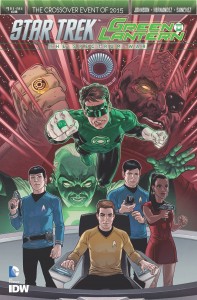 Star Trek/Green Lantern #1 (of 6) — Writer: Mike Johnson; Art: Angel Hernandez; Colors: Alejandro Sanchez
Star Trek/Green Lantern #1 (of 6) — Writer: Mike Johnson; Art: Angel Hernandez; Colors: Alejandro Sanchez
All-Star Section Eight #2 — Writer: Garth Ennis; Art: John McCrea; Colors: John Kalisz
Constantine: The Hellraiser #2 — Writers: Ming Doyle and James Tynion IV; Art: Riley Rossmo; Colors: Ivan Plascencia
 Justice League of America #2 — Writer/Pencils: Bryan Hitch; Inks: Daniel Henriques, Andrew Currie and Bryan Hitch; Colors: Alex Sinclair
Justice League of America #2 — Writer/Pencils: Bryan Hitch; Inks: Daniel Henriques, Andrew Currie and Bryan Hitch; Colors: Alex Sinclair
Red Hood/Arsenal #2 — Writer: Scott Lobdell; Art: Paolo Pantalena; Colors: Tanya Horie and Blond
Starfire #2 — Writers: Amanda Connor and Jimmy Palmiotti; Pencils: Emanuela  Lupacchino; Inks: Ray McCarthy; Colors: Hi-Fi
Lupacchino; Inks: Ray McCarthy; Colors: Hi-Fi
Only one DC debut this week (and its a mini-series, not an ongoing title), although there are a bunch of second issues. That book, Star Trek/Green Lantern, involves the Enterprise crew stumbling across a dead planet, beaming down and discovering the skeleton of a Guardian, along with six rings of various colors. They take them back to the ship, and just as they’re having a confrontation with a 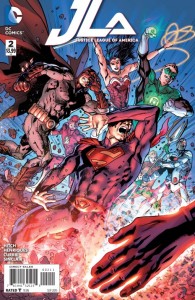 Klingon vessel their probing awakens the rings, which promptly seek out new owners — with predictably chaotic results. And then Hal Jordan shows up…. It takes a while to get used to the characters’ appearances being new-Trek instead of classic (so we get a vaguely Zach Quinto Spock instead of a Leonard Nimoy one), but the creators seem to be having fun with the concept, and their enthusiasm is infectious. Of the sophomore efforts, All-Star Section Eight has Six-Pack trying to recruit Green Lantern to fill out his crew (Hal Jordan’s having a busy week); Ellis and McRea did
Klingon vessel their probing awakens the rings, which promptly seek out new owners — with predictably chaotic results. And then Hal Jordan shows up…. It takes a while to get used to the characters’ appearances being new-Trek instead of classic (so we get a vaguely Zach Quinto Spock instead of a Leonard Nimoy one), but the creators seem to be having fun with the concept, and their enthusiasm is infectious. Of the sophomore efforts, All-Star Section Eight has Six-Pack trying to recruit Green Lantern to fill out his crew (Hal Jordan’s having a busy week); Ellis and McRea did 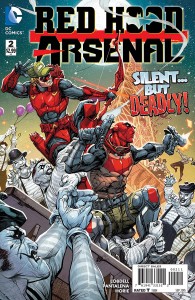 something similar in Hitman with Kyle Raynor, making fun of him along the way, but Jordan has (a) a big stick up his butt about it, and (b) enough meta-awareness to directly threaten to sue the comic’s creators. This is such a weird book that I can’t see it lasting more than twelve issues, but it should generate some solid amusement along the way. Constantine has its main character’s requisite amusement with the world, too, but it’s tinged with that book’s normal cynicism and world-weariness; the big attraction is still the Rossmo art, as he gives John a youthfulness and slightly-otherworldly aura that he’s been missing for awhile. JLA is another book that depends on its artist (who, in this case, is also the
something similar in Hitman with Kyle Raynor, making fun of him along the way, but Jordan has (a) a big stick up his butt about it, and (b) enough meta-awareness to directly threaten to sue the comic’s creators. This is such a weird book that I can’t see it lasting more than twelve issues, but it should generate some solid amusement along the way. Constantine has its main character’s requisite amusement with the world, too, but it’s tinged with that book’s normal cynicism and world-weariness; the big attraction is still the Rossmo art, as he gives John a youthfulness and slightly-otherworldly aura that he’s been missing for awhile. JLA is another book that depends on its artist (who, in this case, is also the  writer), as the plot, involving Superman’s Kryptonian god Rao apparently coming to Earth, is kind of standard — but everything looks so pretty that it’s hard to complain. Red Hood/Arsenal is a superhero/mercenary buddy comic, with the characters doing pretty much exactly what they’ve been doing the last couple of years — which is fine if you like that sort of thing; Starfire does more to change up its heroine, adopting a light touch that emphasizes her innocence about Earth customs and her instinctive willingness to do the right thing; that makes her kind of the anti-Harley Quinn, an interesting take considering that the book’s writers provide scripts for that comic too.
writer), as the plot, involving Superman’s Kryptonian god Rao apparently coming to Earth, is kind of standard — but everything looks so pretty that it’s hard to complain. Red Hood/Arsenal is a superhero/mercenary buddy comic, with the characters doing pretty much exactly what they’ve been doing the last couple of years — which is fine if you like that sort of thing; Starfire does more to change up its heroine, adopting a light touch that emphasizes her innocence about Earth customs and her instinctive willingness to do the right thing; that makes her kind of the anti-Harley Quinn, an interesting take considering that the book’s writers provide scripts for that comic too.
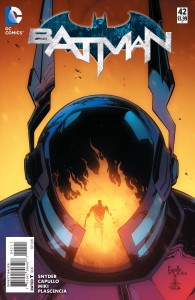 Batman #42 — Writer: Scott Snyder; Pencils: Greg Capullo; Inks: Danny Miki; Colors: FCO Plascencia
Batman #42 — Writer: Scott Snyder; Pencils: Greg Capullo; Inks: Danny Miki; Colors: FCO Plascencia
Batman/Superman #22 — Writer: Greg Pak; Art: Adrian Syaf; Inks: Vicente Cifuentes; Colors: Dean White, Beth Sotelo and Blond
Two other DC books, both involving the “new” Batman, Jim Gordon in an exoskeleton. The regular Batman has him learning the ropes, with Snyder managing to make the situation a lot more interesting than it sounds (I mean, it  would have to be…), and has a last-page confrontation that ought to bring everyone back next month. Batman/Superman continues to feature the new, outed, mostly-depowered Clark Kent, as he’s in Gotham on a case, but he and Gordon neither like nor trust one another, leading to inevitable conflict. It’s fun watching the two off-model heroes interact, which had to be exactly what DC was going for when they made the changes in the first place; while it might get old eventually, right now it’s still got that new-car smell to keep readers coming back to this book, too.
would have to be…), and has a last-page confrontation that ought to bring everyone back next month. Batman/Superman continues to feature the new, outed, mostly-depowered Clark Kent, as he’s in Gotham on a case, but he and Gordon neither like nor trust one another, leading to inevitable conflict. It’s fun watching the two off-model heroes interact, which had to be exactly what DC was going for when they made the changes in the first place; while it might get old eventually, right now it’s still got that new-car smell to keep readers coming back to this book, too.
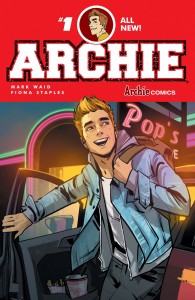 Archie #1 — Writer: Mark Waid; Art: Fiona Staples; Colors: Andre Szymanowicz with Jen Vaughan
Archie #1 — Writer: Mark Waid; Art: Fiona Staples; Colors: Andre Szymanowicz with Jen Vaughan
Negative Space #1 — Writer: Ryan K. Lindsay; Art: Owen Gieni
Strange Fruit #1 (of 4) — Writer: Mark Waid; Art/Story/Colors: J. C. Jones
A couple of indy first issues (if Archie Comics can be called “indy…”), and Archie is the most interesting, a re-imaging of a character who settled into his Dan DeCarlo house style sometime in the early ’60s — although, as this issue’s reprint of the very first Archie story, from 1941, reminds us, that was far from the redheaded teen’s first look. Waid actually duplicates a number of elements from that first  story: only Betty, and no Veronica, and Jughead as the voice of reason — and keeps the Archie innocence and good-heartedness, but ditches his propensity for slapstick and pratfalls. Ditching the bigfooted insanity makes the kid more realistic (and plays to Staples’s artistic strengths, as her solid, up-to-date but just-slightly-cartoonish world makes us forget about earlier versions of the Riverdale residents and just accept this one instead), but loses some of the original’s anarchic energy; whether that’s a fair trade should become clear in a couple of months. Negative Space is kind of Grant Morrison-y (as you can tell by the cover, which wouldn’t be out of place on Nameless), in its tale of an empathetic writer whom a mysterious all-powerful society is trying to get to commit suicide, apparently because if not he’ll affect everyone’s emotions and
story: only Betty, and no Veronica, and Jughead as the voice of reason — and keeps the Archie innocence and good-heartedness, but ditches his propensity for slapstick and pratfalls. Ditching the bigfooted insanity makes the kid more realistic (and plays to Staples’s artistic strengths, as her solid, up-to-date but just-slightly-cartoonish world makes us forget about earlier versions of the Riverdale residents and just accept this one instead), but loses some of the original’s anarchic energy; whether that’s a fair trade should become clear in a couple of months. Negative Space is kind of Grant Morrison-y (as you can tell by the cover, which wouldn’t be out of place on Nameless), in its tale of an empathetic writer whom a mysterious all-powerful society is trying to get to commit suicide, apparently because if not he’ll affect everyone’s emotions and 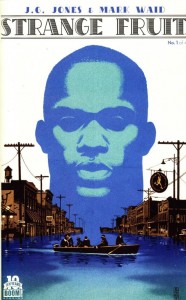 attract some horrible alien predators. OK, and the art has some nice Sam Keith-ish impressionism to it, although young writers writing about other young writers who are empathetic and quietly noble and kind of think of themselves as losers, but are secretly really good, is pretty much a definition of “a little too on the nose.” Strange Fruit is set in the late-1920s South, and takes its name from the haunting Billie Holiday song about lynchings. It starts out grim and realistic (with Jones’s art, lush and detailed, its best feature), but then swerves into superhero territory — in fact, it’s very reminiscent of the origin of the Milestone Comics hero Icon. It’s also lucky enough to be mainlining the zeitgeist: given the events of the last week, its last-page image is provocative as a cattle prod.
attract some horrible alien predators. OK, and the art has some nice Sam Keith-ish impressionism to it, although young writers writing about other young writers who are empathetic and quietly noble and kind of think of themselves as losers, but are secretly really good, is pretty much a definition of “a little too on the nose.” Strange Fruit is set in the late-1920s South, and takes its name from the haunting Billie Holiday song about lynchings. It starts out grim and realistic (with Jones’s art, lush and detailed, its best feature), but then swerves into superhero territory — in fact, it’s very reminiscent of the origin of the Milestone Comics hero Icon. It’s also lucky enough to be mainlining the zeitgeist: given the events of the last week, its last-page image is provocative as a cattle prod.
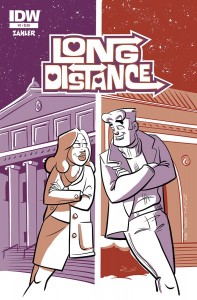 Long Distance #2 — Writer/Artist: Thom Zahler
Long Distance #2 — Writer/Artist: Thom Zahler
Providence #2 — Writer: Alan Moore; Art: Jacen Burrows; Colors: Juan Rodriguez
Injection #3 — Writer: Warren Ellis; Art: Declan Shalvey; Colors: Jordie Bellaire
 Saga #30 — Writer: Brian K. Vaughan; Art/Colors: Fiona Staples
Saga #30 — Writer: Brian K. Vaughan; Art/Colors: Fiona Staples
Rebels #4 — Writer: Brian Wood; Art: Andrea Mutti; Colors: Jordie Bellaire
The Fox #4 — Writers: Dean Haspiel and Mark 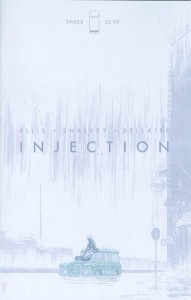 Waid; Art: Dean Haspiel; Colors: Allen Passalaqua
Waid; Art: Dean Haspiel; Colors: Allen Passalaqua
The other good stuff for the week: Long Distance is a story about a couple in, yes, a long-distance relationship; it’s told in an Archie style (well, what used to be an “Archie” style…), and it’s loaded with charm, insight and very clear storytelling: its 44 pages of art flow by so smoothly that the reader is startled when it’s 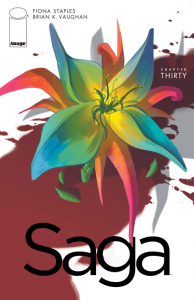 over, and wants to see more. Providence is the opposite of “charming”: it’s Alan Moore and Jacen Burrows doing creeping Lovecraftian horror (as they’ve done before, in The Courtyard and Neonomicon); it builds its tale slowly, brick by careful brick, and then startles the reader with flashes of weirdness and terror. Injection is Warren Ellis mining some of the same ground, but overlaying/explaining the occult and fantasy aspects of his story with hard science; it’s
over, and wants to see more. Providence is the opposite of “charming”: it’s Alan Moore and Jacen Burrows doing creeping Lovecraftian horror (as they’ve done before, in The Courtyard and Neonomicon); it builds its tale slowly, brick by careful brick, and then startles the reader with flashes of weirdness and terror. Injection is Warren Ellis mining some of the same ground, but overlaying/explaining the occult and fantasy aspects of his story with hard science; it’s  another book that started with a slow build, but if you read this third issue along with the first two, all at once, there’s enough information and backstory to make it all hang together, and offer a compelling narrative. Saga, meanwhile, is still its effective combination of sprawling galactic society and small-scale human interaction, and reaches the end of its fifth arc with this issue (the creative team does six issues at a time, collects them in a trade, and then takes a break); Staples’s art, as always, is a marvel, and shows why she was on the Archie people’s radar.
another book that started with a slow build, but if you read this third issue along with the first two, all at once, there’s enough information and backstory to make it all hang together, and offer a compelling narrative. Saga, meanwhile, is still its effective combination of sprawling galactic society and small-scale human interaction, and reaches the end of its fifth arc with this issue (the creative team does six issues at a time, collects them in a trade, and then takes a break); Staples’s art, as always, is a marvel, and shows why she was on the Archie people’s radar.  Rebels is about the American Revolutionary War, and its first long story continues to focus on Ethan Allen and the Green Mountain Boys; it’s another book with nice-looking art, and a winning combination of historical sweep and small, pinpoint human frailties and interactions. That leaves The Fox, a tale about a reluctant costumed adventurer in which artist/creator Dean Haspiel manages to mix precise panel composition with a fluid style that, combined with the character’s simple-but-elegant visuals, makes for a very good-looking comic — and the perfect place to end this list.
Rebels is about the American Revolutionary War, and its first long story continues to focus on Ethan Allen and the Green Mountain Boys; it’s another book with nice-looking art, and a winning combination of historical sweep and small, pinpoint human frailties and interactions. That leaves The Fox, a tale about a reluctant costumed adventurer in which artist/creator Dean Haspiel manages to mix precise panel composition with a fluid style that, combined with the character’s simple-but-elegant visuals, makes for a very good-looking comic — and the perfect place to end this list.



